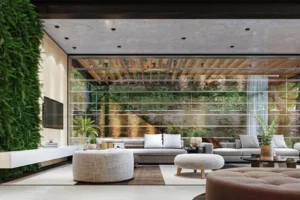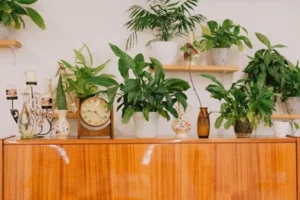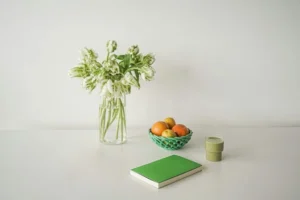If you’re growing leafy greens, herbs, or small fruits indoors, chances are you’ve turned to compact shelving units to make the most of your limited space. Stackable racks and narrow towers can turn even the tightest corners into a lush green oasis. But there’s one part of the setup that often causes more headaches than it should: keeping your plants consistently watered.
With traditional watering, you end up crouching, reaching behind grow lights, and awkwardly pouring water into trays—sometimes over-watering the top shelf and under-watering the bottom. It’s not only inefficient but also unsustainable if you’re managing multiple tiers or trying to stick to a tight daily routine.
That’s where low-maintenance irrigation schemes come into play.
This article focuses specifically on design-level irrigation solutions for compact shelf-based grow setups. We’re not talking about tips for how to water or which nutrients to use—this is about creating self-sustaining, reliable watering systems that minimize your daily input and maximize long-term consistency.
Whether you’re working with gravity-fed setups, small pumps, or capillary-based systems, we’ll explore a range of strategies that blend DIY creativity with smart planning. By the end, you’ll be able to choose or build a watering scheme that works with your shelving—not against it.
Let’s design a setup that lets you grow more… and water less.
Principles of Low-Maintenance Irrigation Design
Before diving into specific setups, it’s important to step back and understand what actually makes an irrigation scheme low-maintenance. In small-space gardening, especially when you’re using shelf units or stacked growing racks, a successful watering system isn’t just about getting water from point A to point B—it’s about doing it reliably, efficiently, and with minimal interference in your day-to-day life.
Here are the five core principles that define a well-designed low-maintenance irrigation system for compact shelving:
Automation
At the heart of low-maintenance is automation. Whether you’re using gravity, timers, or passive wicking, the less you have to intervene manually, the better. Good automation ensures plants are watered consistently—even when you’re busy, traveling, or just forgetful.
Compact Integration
The irrigation should work with your shelves, not against them. Tubes, trays, or wicks should fit naturally into your structure. Avoid setups that require moving plants to water them. Integration means everything has its place, and nothing feels like an afterthought.
Scalability
Your needs may grow, and your system should too. Can you easily add another shelf or connect more plants without redoing the entire watering setup? Smart schemes plan for expansion from the start.
Cleanability
Filters clog. Water lines get slimy. A good system is easy to disassemble and clean without disturbing your entire grow area.
Water Efficiency
Especially in urban settings, waste is costly. Irrigation should avoid runoff and deliver moisture precisely where it’s needed, minimizing evaporation and overwatering.
Keep these five pillars in mind as we explore the three main irrigation schemes designed specifically for compact, shelf-based growing setups.
Gravity-Driven Reservoir with Shelf-Level Drip Distribution
If you’re aiming for simplicity and independence from electrical components, a gravity-driven drip setup might be your best friend. This scheme uses one of the oldest tricks in the book—gravity—to keep your plants watered across stacked shelving tiers.
How It Works
At its core, this setup relies on placing a water reservoir above the highest plant shelf. From there, water travels down through tubing, feeding each shelf through adjustable drip emitters. It’s a controlled cascade where each tier gets its share—no pumps, no power, just flow driven by elevation.
What You’ll Need
- An elevated water container (bucket, tank, or jug)
- Food-safe tubing (¼” is common for small-scale use)
- Inline drip emitters or flow restrictors
- T-connectors or manifolds for splitting flow between shelves
- A simple ball valve to control the master flow
If you’re short on vertical space, try wall-mounting the reservoir or placing it on top of an adjacent cabinet or shelf. Some growers repurpose collapsible camping bladders or stackable water containers.
Why It Works Well for Compact Shelving
Gravity-fed systems are perfect for shelf units because they allow you to tuck the tubing neatly along vertical supports. You can route water directly to individual containers or into shallow trays with drainage, depending on your setup. With no electricity involved, these systems are near-silent and immune to power outages.
Pros
- Zero energy cost
- Very quiet operation
- Low setup cost with basic materials
- Highly customizable
Cons
- Requires vertical height for pressure
- Water flow must be fine-tuned to avoid over- or under-watering
- Refilling the elevated tank can be awkward in very tight spaces
For DIY growers looking for reliability and control without needing electronics or moving parts, this scheme is a solid foundation to build on.
Recirculating Pump Grid with Timed Water Flow
If you’re comfortable with a bit of tech and want more precision, a recirculating pump grid offers the next level of control. This scheme uses a small submersible pump, typically housed in a base reservoir, to push water up and across your shelves on a scheduled cycle.
How It Works
Water is pumped from a tank at the bottom of your shelf unit and directed through a network of tubing that branches out to each grow level. After watering the plants, the excess water drains back into the same reservoir—creating a closed-loop, recirculating system.
You control the watering frequency using a plug-in timer or a smart switch, setting it to run for just a few minutes per day.
Materials You’ll Need
- Submersible water pump (aquarium or fountain pump is ideal)
- Food-safe vinyl tubing (typically ¼” or ½”)
- T-connectors and manifolds
- Return tubing for drainage
- Basic mesh filter to protect the pump
- Electrical timer or smart outlet
- Reservoir (storage bin, bucket, or low-profile tank)
Why It Works for Shelf-Based Setups
Compact shelving units often have just enough room at the base for a reservoir. With proper planning, tubing can be run cleanly along the shelf legs or behind your grow lights. The pump’s small footprint and low voltage make it safe and efficient for indoor use.
Pros
- Highly consistent watering cycles
- Excellent for denser setups with multiple tiers
- Saves water through reuse
- Easily adjustable for different plant types
Cons
- Needs periodic pump and tubing cleaning
- Slight hum or vibration depending on the pump
- Dependent on power supply (though battery backups exist)
If you’re ready to take a more engineered approach to your grow setup, a recirculating grid offers both efficiency and precision—especially as your plant count increases.
Wick-Based Tray Arrays with Passive Capillary Irrigation
For growers who want the absolute minimum in maintenance and complexity, a wick-based irrigation setup is one of the most elegant solutions—especially for compact shelving. This method relies on capillary action, where moisture naturally travels from a reservoir to your plants through a simple wick.
How It Works
Each plant container sits on top of or near a water reservoir. A wick—usually made of cotton rope, felt strips, or microfiber—connects the two. As the soil or grow medium dries out, the wick pulls up just enough water to maintain consistent moisture levels.
You can also scale this method with shallow trays lined with absorbent fabric (like capillary mats), where multiple containers can sit and share water passively.
What You’ll Need
- Cotton or synthetic wicking material
- Containers with holes or slots for the wick
- A base tray or reservoir per shelf
- Optionally, capillary mats or sponge sheets
- Water-level indicators (optional but handy)
Why It Works Well for Shelving
This is one of the quietest, cleanest systems for compact indoor gardens. There are no moving parts, and wicks can easily be run up or down shelving gaps. It also pairs beautifully with repurposed materials like plastic bottles, mason jars, or storage tubs.
Pros
- No electricity or timers required
- Ideal for herbs, greens, and low-demand plants
- Silent, simple, and easy to install
- Incredibly low maintenance once set up
Cons
- Not suited for heavy-feeding or thirsty crops
- Wicks may need occasional replacement due to mold or blockage
- Less control over exact water delivery rates
If you’re a minimalist at heart or just want a plug-and-forget approach, wick irrigation offers a surprisingly reliable solution—especially for shelf-based systems.
How to Choose the Right Scheme for Your Setup
Now that you’ve explored three solid irrigation options, how do you figure out which one fits your compact shelving setup best? The answer depends on a mix of factors—space, time, goals, and the type of plants you’re growing.
Here’s a quick guide to help you match your needs with the right scheme:
If You Prefer a Hands-Off, Power-Free Setup
Go with the gravity-fed drip method. It’s perfect for those who want to avoid electronics and prefer a system that can be up and running with just a few buckets and tubing. You’ll just need enough vertical clearance for the reservoir to do its thing.
If You Like Precision and Are Comfortable with Tech
Try the recirculating pump grid. This is the best choice for maximizing output while still keeping things relatively low-maintenance. It’s especially helpful if you grow multiple types of plants with different needs, as you can fine-tune the watering schedule with a timer.
If You Want Ultra-Simple, Passive Watering
The wicking setup is ideal. It’s the most beginner-friendly in terms of maintenance and still very effective for low-demand plants like herbs and greens. This is great if you’re working with shallow shelving or want a super-quiet, invisible system.
Consider your space limitations, how involved you want to be, and how much growth you expect. Most importantly, choose a scheme that doesn’t just fit your shelving—it fits your lifestyle.
Hybrid Schemes That Combine Strengths
One of the best parts of working with compact shelving is the freedom to mix and match irrigation strategies. You don’t have to commit to just one scheme—hybrids can often give you the best of both worlds.
Example 1: Gravity Meets Wicking
Use a gravity-fed reservoir to fill shallow trays on each shelf, then rely on capillary mats or rope wicks to deliver moisture to your plant containers. This reduces your refill frequency and eliminates the need for electricity while adding more even water distribution.
Example 2: Recirculating + Passive Backup
Set up a pump-driven loop on a timer for your main watering cycles but include passive wicks in the plant containers. That way, if the pump ever fails or misses a cycle, your plants still get water through capillary action.
Example 3: Modular Add-ons
Start with a passive wicking system, then upgrade a single shelf with a timed recirculating pump if you introduce thirstier crops. This modular approach keeps your system adaptable as your skills (and plant count) grow.
Hybrid approaches let you customize your setup tier by tier, so each shelf gets what it needs—without overcomplicating your entire build.
End Notes for Effortless Watering
Smart irrigation isn’t about expensive tech or flashy gadgets. It’s about thoughtful design from the start. If your shelving setup is well-planned, the watering becomes almost automatic.
Start simple. Test one method and see how your plants respond. You’ll learn what works best for your space and time.
The right layout can save water, reduce mess, and give your greens exactly what they need—without constant supervision.
Don’t be afraid to mix and adapt these watering schemes. Even a minor tweak can make your indoor garden easier to manage.
Plan it well, and you’ll spend more time harvesting crisp herbs and leafy greens—and less time fiddling with hoses and timers.




